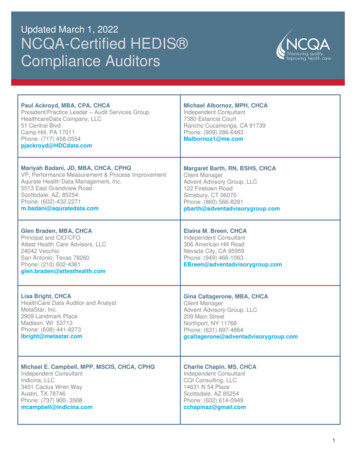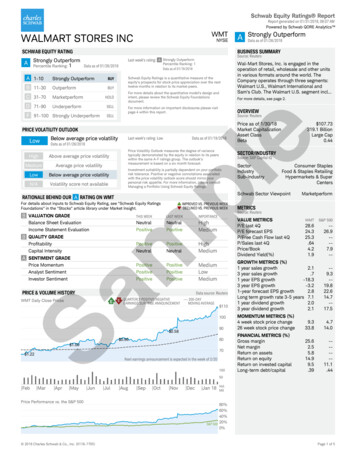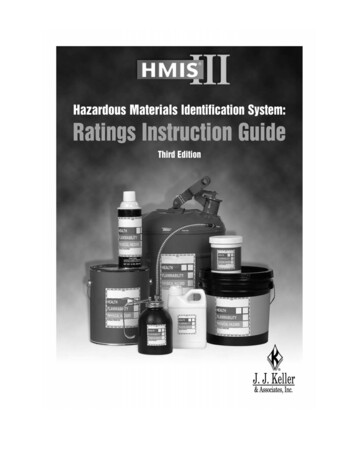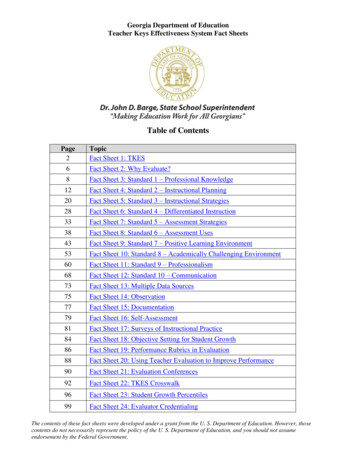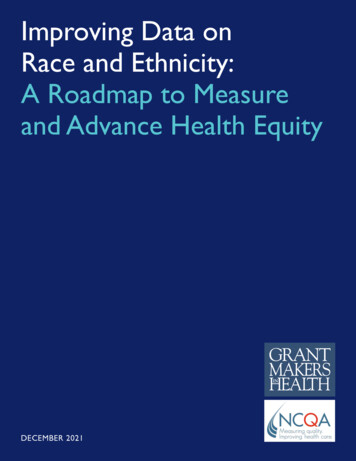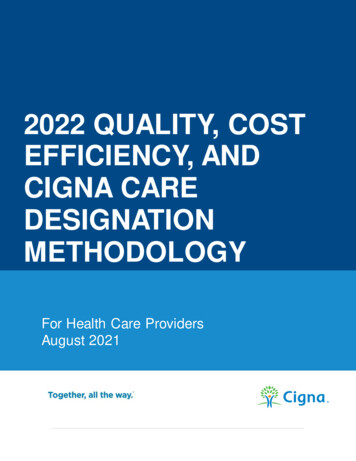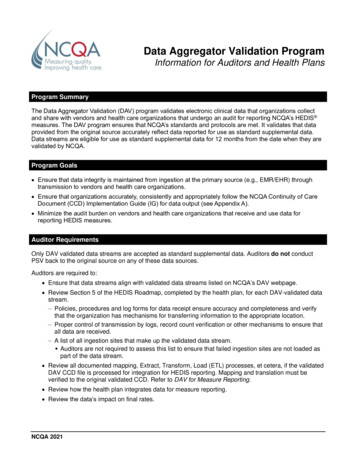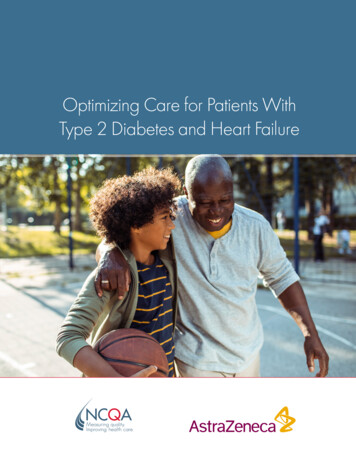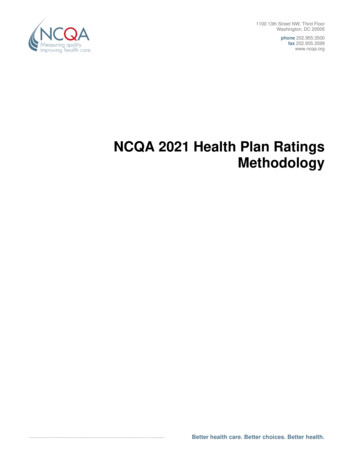
Transcription
1100 13th Street NW, Third FloorWashington, DC 20005phone 202.955.3500fax 202.955.3599www.ncqa.orgNCQA 2021 Health Plan RatingsMethodologyBetter health care. Better choices. Better health.
Table of ContentsTable of ContentsNCQA 2021 Health Plan Ratings Methodology . 1How Are Plans Rated? . 1Overall Rating . 1Special Overall Rating policy . 2Rounding rules. 2Measures included . 2HEDIS compliance audit results . 3Audit results for HEDIS measures . 3Audit results for survey frames . 3Handling missing values . 3Measure weights. 3Accreditation status and status modifiers . 3Final Plan Rating . 4Measure and composite ratings . 4Deriving ratings from individual results and national benchmarks and percentiles . 4Inverted rates . 4Accessing the benchmarks and percentiles . 4How Are Plans Displayed? . 5What plans are rated or receive scores? . 5Plans with partial data . 5No data reported . 5Additional Rules . 5Medicaid CAHPS and benchmarks . 5Medicare CAHPS and Health Outcomes Survey . 51876 cost plans. 6Other display scenarios . 6Special Needs Plans . 7Schedule, Advertising and Publicity Guidelines and Seals . 7Results . 7Measure Lists . 7HEDIS Reporting for Accreditation . 7Reporting by product and product line . 7HEDIS/CAHPS reporting unit . 8Minimum enrollment threshold for HEDIS/CAHPS reporting . 8Reporting units with 15,000 members . 8Combining Accreditable entities and HEDIS/CAHPS reporting units . 9Combining across CMS regions in limited situations . 9Approval process for HEDIS state combining requests . 9 2021 National Committee for Quality Assurance
NCQA 2021 Health Plan Ratings Methodology1NCQA 2021 Health Plan Ratings MethodologySummary of ChangesJuly 30, 2021 Revised the language in the Special Overall Rating policy section to clarify that the NCQA will use thebetter of the Overall Rating score between HPR 2019 and HPR 2021, for plans with a current Accredited,Provisional and Interim status, and that Medicare HPR will use 2019 CAHPS and HOS data (MY 2018). Added a new Inverted rates section and text. In the No data reported section, replaced the references to “In-Process” or “Scheduled” for AccreditationSurvey with “Accredited,” “Interim” or “Provisional.”December 18, 2020 Revised the language in the Special Overall Rating policy section to clarify that the individual measure,composite and subcomposite rates will be scored and displayed based on measurement year (MY) 2020data for all plans. Added “Merger Review in Process” and “Appealed by Plan” statuses in the Accreditation Status andStatus Modifiers section. Added the HEDIS Reporting for Accreditation section to account for general rules and specialcircumstances in reporting HEDIS measures that are required for Accredited plans.Note: This section was previously included in HEDIS Volume 2: Technical Specifications for Health Plans.How Are Plans Rated?Health plans are rated in three categories: private/commercial plans in which people enroll through work oron their own; plans that serve Medicare1 beneficiaries in the Medicare Advantage program (notsupplemental plans); and plans that serve Medicaid beneficiaries.NCQA ratings are based on three types of quality measures: measures of clinical quality from NCQA’sHealthcare Effectiveness Data and Information Set (HEDIS 2) and Health Outcome Survey (HOS);measures of patient experience using the Consumer Assessment of Healthcare Providers and Systems(CAHPS 3); and results from NCQA’s review of a health plan’s health quality processes (NCQAAccreditation). NCQA rates health plans that choose to report measures publicly.Note: If an Accredited plan that is not yet required to report HEDIS/CAHPS data for Accreditation chooses topublicly report its performance data, it is scored on the data submitted and receives the Accreditation bonuspoints. If an Accredited plan that is not yet required to report HEDIS/CAHPS data chooses not to publicly reportperformance data, it will not have a rating.Overall RatingThe overall rating is the weighted average of a plan’s HEDIS and CAHPS measure ratings, plusAccreditation bonus points (if the plan is Accredited by NCQA), rounded to the nearest half point displayedas stars (see below for rounding rules).The overall rating is based on performance on dozens of measures of care and is calculated on a 0–5 scalein half points (5 is highest). Performance includes three subcategories (also scored 0–5 in half points):1Medicareratings on approval from the Centers for Medicare & Medicaid Services (CMS).is a registered trademark of the National Committee for Quality Assurance (NCQA).3CAHPS is a registered trademark of the Agency for Healthcare Research and Quality (AHRQ).2HEDIS 2021 National Committee for Quality Assurance
2NCQA 2021 Health Plan Ratings Methodology1. Patient Experience: Patient-reported experience of care, including experience with doctors, servicesand customer service (measures in the Patient Experience category).2. Rates for Clinical Measures: The proportion of eligible members who received preventive services(prevention measures) and the proportion of eligible members who received recommended care forcertain conditions (treatment measures).3. NCQA Health Plan Accreditation: For a plan with an Accredited or Provisional status, 0.5 bonuspoints are added to the overall rating before rounded to the nearest half point and displayed as stars.A plan with an Interim status receives 0.15 bonus points added to the overall rating before rounded tothe nearest half point and displayed as stars.Special OverallRating policyIn response to COVID-19’s impact to health plans, NCQA will implement aspecial Overall Rating Policy for NCQA-Accredited plans. Ratings 2021 willdisplay the better of the Overall Rating score between HPR 2019 and HPR 2021,for plans with Accredited, Provisional and Interim status as of June 30, 2021.Individual measures, subcomposites and composites will continue to be scoredand displayed using HPR 2021 performance (i.e., MY 2020 data) for all plans.Medicare HPR will use 2019 CAHPS and HOS data (MY 2018).Rounding rulesThe overall rating is calculated and truncated to 3 decimal places and roundaccording to the rules below.Rounding Rules0.000–0.249 0.02.750–3.249 3.00.250–0.749 0.53.250–3.749 3.50.750–1.249 1.03.750–4.249 4.01.250–1.749 1.54.250–4.749 4.51.750–2.249 2.0 4.750 5.02.250–2.749 2.5MeasuresincludedAll publicly reportable clinical and patient experience measures are eligible forinclusion. Selected measures have good differentiating properties, up-to-dateevidence and high population impact.Refer to https://www.ncqa.org/hedis/reports-and-research/ for a full list ofmeasures and weights.The following Risk-Adjusted Utilization measures are required to be reported forAccredited plans but were removed for HPR 2021 scoring due to concerns aboutappropriate risk-adjusted predictions for expected rates in measurement year2020: PCR—Plan All-Cause Readmissions (commercial, Medicare) EDU—Emergency Department Utilization (commercial, Medicare) AHU—Acute Hospital Utilization (commercial, Medicare) HPC—Hospitalization for Potentially Preventable Complications (Medicare) 2021 National Committee for Quality Assurance
NCQA 2021 Health Plan Ratings MethodologyHEDIScomplianceaudit resultsNCQA Certified HEDIS Compliance Auditors must audit HEDIS results submittedby the organization. HEDIS Compliance Audits result in audited rates orcalculations at the measure level and indicate if the measures can be publiclyreported. All measures selected for public reporting must have a final, auditedresult. The auditor approves the rate or report status of each measure and surveyincluded in the audit, as shown below.Audit results forHEDIS measures Reportable (R). A reportable rate was submitted for the measure. Small Denominator (NA). The organization followed the specifications, but thedenominator was too small (e.g., 30 for Effectiveness of Care measures) toreport a valid rate. No Benefit (NB). The organization did not offer the health benefit required by themeasure (e.g., mental health, chemical dependency). Not Reported (NR). The organization chose not to report the measure. Biased Rate (BR). The calculated rate was materially biased. Not Required (NQ). The organization was not required to report the measure.Audit results forsurvey frames Supports Reporting. The survey sample frame was reviewed and approved.Handlingmissing valuesMeasures that are not reported (NR), not required (NQ) or have biased rates (BR)are given a rating of “0.” Not Reportable. The survey sample frame was incomplete or materially biased.Measures with missing values because of small denominators (NA), or becausethe plan did not offer the benefit (NB), are not used in the plan’s composite oroverall rating. A plan must have scorable rates (a valid performance rate, NR, NQ,BR) for at least half of all measures by weight to receive an overall rating.Note: Plans seeking Accreditation may not report NQ for performance measuresincluded in the ratings methodology.Measure weights Process measures (such as screenings) are given a weight of 1. Outcome and intermediate outcome measures (e.g., HbA1c or blood pressurecontrol and childhood immunizations) are given a weight of 3. Patient experience measures are given a weight of 1.5.Note: New measures used for scoring are assigned a measure weight of 1.0 and thenreassessed to determine their weight going into the second year.Accreditationstatus andstatus modifiersA plan’s Accreditation status is determined as of June 30. If a plan has an NCQAstatus modifier (e.g., Under Review, Under Corrective Action, Merger Review inProcess, Appealed by Plan) as of June 30, it will be appended to the Accreditationstatus.Table 1. NCQA Accreditation Bonus PointsAccreditation AchievedAccreditation Bonus PointsAccredited or Provisional0.5Interim0.15In Process0Scheduled0None0 2021 National Committee for Quality Assurance3
4NCQA 2021 Health Plan Ratings MethodologyFinal Plan RatingMeasure andcompositeratingsNCQA combines and sorts measures into categories according to conceptuallyrelated services. Ratings are displayed at the composite, subcomposite andindividual measure level.A composite or subcomposite rating is the weighted average of a plan’s HEDISand CAHPS measure ratings in those categories. The weight of any NR, NQ andBR measure is included. NCQA uses the following formula to score compositesand subcomposites:(Sub) Composite Rating (measure rating * measure weight) / weightsDeriving ratingsfrom individualresults andnationalbenchmarks andpercentilesThe National All Lines of Business 10th, 33.33rd, 66.67th and 90th measurebenchmarks and percentiles are used for ratings, calculated as whole numbers ona 1–5 scale. HPR truncates final raw rates and percentiles to 3 decimals and thenassigns the measure rating that the plans receive for each measure as follows:RatingA plan that is in the top decile of plans. 5A plan that is in the top 3rd of plans but not in the top 10th. 4A plan in the middle 3rd of all plans . 3A plan that is in the bottom 3rd of plans but not in the bottom 10% . 2A plan that is in the bottom 10% of plans . 1Note: Due to COVID-19’s unknown impact on plan performance, HPR 2021 will usedata from the current reporting year to calculate the national benchmarks andpercentiles.Inverted ratesFor HPR, NCQA inverts all final rates and percentiles where a lower valuerepresents better performance to a higher value represents better performancescale in the HPR scoresheets and then truncates to 3 decimals. For example, araw rate of .2325 would display as .767 (1 – .2325 .7675, truncated at 3decimals).Accessing thebenchmarks andpercentilesDuring the Projected Ratings sign-off process in early August, all eligible plans(i.e., all non-Partial Data Reported and No Data Reported) will be provided anExcel workbook(s) that displays all scoring information, including the benchmarksand percentiles used to help plans better confirm the accuracy of their score.NCQA Primary HEDIS and Accreditation contacts will have access to the Excelworkbook(s). Access has been limited for all other customers to ensure that thebenchmarks and percentiles are used solely for their intended purpose (toestimate an organization’s performance for ratings) and not for generalbenchmarking or commercial purposes. 2021 National Committee for Quality Assurance
NCQA 2021 Health Plan Ratings MethodologyHow Are Plans Displayed?What plans arerated or receivescores?Plans with complete data (both HEDIS and CAHPS) that have elected to publiclyreport data are rated; plans with partial or no data, or that do not publicly report,are listed but not rated.Plans withpartial dataPlans with partial data do not receive a rating, but NCQA lists them in the ratingsand shows their scores on the measures they report. A plan is considered to havepartial data if it: Submits HEDIS and CAHPS measure data for public reporting, but has“missing values” NA or NB in more than 50% of the weight of measuresused in the methodology. Plans that fall into this category receive an overallrating status of “Partial Data Reported” and their measure rates aredisplayed as “NC” (No Credit). Refer to HEDIS Volume 2: TechnicalSpecifications for information about missing values. Submits HEDIS data for public reporting but does not submit CAHPS data,or vice versa. Plans that fall into this category receive an overall ratingstatus of “Partial Data Reported” and their measure rates for the datasetthey did not submit are displayed as “NC.” Earned NCQA Accreditation without HEDIS data (Health Plan Accreditationstandards only) and did not submit HEDIS or CAHPS data for publicreporting. Plans that fall into this category receive an overall rating status of“Partial Data Reported” and their measure rates are displayed as “NC.”No data reportedPlans that submit results but do not report data publicly, or that do not reportHEDIS or CAHPS information and are not “Accredited,” “Interim” or “Provisional”receive a rating status of “No Data Reported” and their measure rates aredisplayed as “NC.” Plans that fall into this category and have fewer than 15,000members are omitted—they are not rated and are not listed in displays related toratings.Additional RulesMedicaid CAHPSand benchmarksMedicaid plans may choose the version of the CAHPS survey (or “component”)they want scored: Adult CAHPS, Child CAHPS or Child With Chronic ConditionsCAHPS (Child CCC).4Plans designate the CAHPS component when completing the HealthcareOrganization Questionnaire (HOQ). Designations may not be changed and arebenchmarked by component selected: Adult CAHPS benchmarks are based on adult rates only. Child and Child CCC CAHPS benchmarks are based on the combinedgeneral population rates for both components.Medicare CAHPSand HealthOutcomesSurvey4CAHPSUsing Medicare CAHPS and Health Outcomes Survey (HOS) data in the ratingsdepends on yearly approval from the Centers for Medicare & Medicaid Services(CMS). Because the submission schedule for Medicare CAHPS and HOSmeasures differs from the HEDIS submission schedule, NCQA is usingMeasurement Year (MY) 2018 data. For Medicare plans that were not required tosubmit CAHPS or HOS in the previous year, these measures are displayed as“NA” (Not Applicable).components are described in more detail in HEDIS Volume 3: Specifications for Survey Measures. 2021 National Committee for Quality Assurance5
6NCQA 2021 Health Plan Ratings Methodology1876 cost plansAs of 2017, CMS no longer allows 1876 cost plans to submit data on measuresthat require inpatient data; therefore, submit “NQ” for these measures. “NQ” will betreated the same as “NA” and “NB,” and will not count against a Medicare plan’sPartial Data rule.Other displayscenariosTo simplify the ratings display logic, NCQA developed the following display rules.APPLY FIRSTRate/ScenarioDisplayPlan submits NR (Not Reported) for a measure indicatorNC (No Credit)Plan submits BR (Biased Rate) for a measure indicatorNC (No Credit)Plan submits NQ (Not Required) for a measure indicatorNC (No Credit)Plan submits NA (Not Applicable) for a measure indicatorNA (Not Applicable)Plan submits NB (No Benefit) for a measure indicatorNA (Not Applicable)For Medicare, if “CAHPS Submitted False” and “CAHPSRequired True”Display as NC, overall Rating PartialData ReportedFor Medicare, if “CAHPS Submitted False” and “CAHPSRequired FALSE”Display as NA, overall Rating PartialData ReportedAPPLY SECONDRate/ScenarioDisplayPlan is Accredited on HEDIS/CAHPS and did not elect to publicreport results on the IDSS Attestation. These plans will berated assuming they submitted scorable data for more than50% of measure weights.Plans that are NCQA Accredited withHEDIS and marked their submission“Not Publicly Reported” on theAttestation are eligible for ratings. Allmeasures are used to calculate theiroverall rating and scores for allmeasures are displayed.Plan is Accredited on Standards only but submits HEDIS/CAHPS and did not elect to public report results on the IDSSAttestation. Plans will have an overall rating score of PartialData Reported.NC (No Credit) for all measures.Plan is Accredited on Standards only and did not submit anydata or submitted either HEDIS or CAHPS only. Plans will havean overall rating score of Partial Data Reported.NC (No Credit) for all measures the plandid not submit, except Medicare, whichshould follow the Medicare CAHPSrules above.Plan is not Accredited and submitted either HEDIS or CAHPSonly and said Yes to public reporting on the IDSS Attestation.Plans will have an overall rating score of Partial Data Reported.NC (No Credit) for all measures the plandid not submit, except for Medicare,which should follow the MedicareCAHPS rules above.Rate/ScenarioDisplay 2021 National Committee for Quality Assurance
NCQA 2021 Health Plan Ratings MethodologyPlan is not Accredited or is “In-Process” or “Scheduled” forAccreditation Survey and did not submit any data.NC (No Credit) for all measures.Plan is not Accredited or is “In-Process” or “Scheduled” forAccreditation Survey and submitted data but did not elect topublic report results on the IDSS Attestation. Plans will have anoverall rating score of No Data Reported.NC (No Credit) for all measures.7HPR 2021 COVID-19 Special Overall Rating PolicyRate/ScenarioPlan has current Accreditation as ofJune 30, 2021.DisplayDisplay the higher overall rating score between HPR 2021 andHPR 2019. If the plan did not exist or was not numerically ratedin 2019, display the HPR 2021 overall rating score.For all plans, display the HPR 2021 measure, subcomposite andcomposite scores.Special Needs PlansSpecial Needs Plans (SNP) with all members categorized as “special needs members” according to CMS,are flagged in the rating displays.Schedule, Advertising and Publicity Guidelines and SealsFind the 2021 ratings schedule as well as the Advertising and Publicity Guidelines and Advertising andPublicity Seals at esultsHPR results will be posted on the NCQA Health Plan Report Card in September 2021.Measure ListsFind a list of measures required for Health Plan Accreditation reporting and included in Health Plan Ratingsat EDIS Reporting for AccreditationThe following applies to organizations submitting HEDIS and CAHPS survey results for Interim, First orRenewal Surveys.Reporting byproduct andproduct lineThe organization reports HEDIS/CAHPS survey results: Separately for HMO, POS, PPO and EPO products, as applicable, or Combined for HMO and POS products or PPO and EPO, as applicable, or Combined for HMO and PPO, EPO or POS and PPO or EPO, as applicable, if80% of the organization’s members are in a single practitioner and providernetwork and the organization submits a written request for approval to PCSvia My NCQA (https://my.ncqa.org). 2021 National Committee for Quality Assurance
8NCQA 2021 Health Plan Ratings MethodologyThe organization must collect and report HEDIS and CAHPS results separately, byproduct line, for the covered populations. Audited HEDIS results must reflect theexact product line/product combination for which the organization seeksAccreditation and must include all members covered by the product line/product(e.g., insured and self-insured), unless noted otherwise in the HEDIS specifications.NCQA combines the Accreditation standards score and the HEDIS and CAHPSscore for each product line/product, and issues Accreditation decisions by productline/product (e.g., commercial HMO, Exchange PPO, Medicare HMO).HEDIS/CAHPSreporting unitNCQA evaluates an organization’s HEDIS/CAHPS results at the time of itsAccreditation Survey and annually, between surveys, based on its performance onthe measures. NCQA uses the following criteria to define a HEDIS/CAHPS reportingunit: Product line and product (refer to General Guideline 1: Product-Line Reportingand General Guideline 2: Product-Specific Reporting in HEDIS Volume 2Technical Specifications for Health Plans). Geographic unit.Note: For Accreditation purposes, the HEDIS/CAHPS reporting unit is the same as theAccreditable entity.Minimumenrollmentthreshold forHEDIS/CAHPSreportingNCQA’s goal is to maximize an organization’s ability to produce HEDIS/CAHPSresults. A HEDIS/CAHPS reporting unit must have enough members to calculaterates. Because producing HEDIS/CAHPS results can be resource intensive, NCQAestablished a minimum membership threshold for requiring HEDIS reporting:Reporting unitswith 15,000membersA HEDIS/CAHPS reporting unit (Accreditable entity) with fewer than 15,000members may choose one of the following options for reporting, which it selectsbefore the Accreditation survey begins: A geographic unit with 15,000 or more members in a product/product linesubmits audited HEDIS/CAHPS results to NCQA. Produce and submit a unique set of audited HEDIS/CAHPS results to NCQAto be scored as part of Accreditation. If the results submitted have too manyaudit results of Small Denominator (NA) or No Benefit (NB), the reporting unitmay be scored on standards and CAHPS only or on Standards only. Combine its membership with another reporting unit in accordance with thepolicies described below, if applicable, to submit audited HEDIS/CAHPSresults. Submit CAHPS only. Submit neither HEDIS nor CAHPS and be scored on Standards only.Note: NCQA awards a status no higher than Accredited when Accrediting anorganization on Standards and CAHPS only or Standards only. 2021 National Committee for Quality Assurance
NCQA 2021 Health Plan Ratings MethodologyCombiningAccreditableentities andHEDIS/CAHPSreporting unitsOrganizations may combine two or more HEDIS/CAHPS reporting units(Accreditable entities) into a single unit in order to achieve the minimum reportingthreshold if they meet the following criteria. Reporting units are part of a single legal entity. When combined, reporting units meet all other NCQA criteria for beingdefined as a single Accreditable entity (e.g., licensure, centralization,provider network). Reporting units share contiguous geographic borders (e.g., side-by-side orcorner-to-corner states) and are within the same CMS region.Organizations may not combine reporting for product lines (commercial,Exchange, Medicare, Medicaid), and must combine the fewest number ofreporting units necessary to meet the threshold, allowing all reporting units to beable to report HEDIS/CAHPS for Accreditation. The organization must submitHEDIS/ CAHPS results for all reporting units undergoing Accreditation within aCMS region when combining results.Combining acrossCMS regions inlimited situationsMembership for bordering states that cross CMS regions may be combined if allother conditions for combining are met, and the organization is not “licensed” or“selling” in the adjacent state but has members residing across the border.Approval processfor HEDIS statecombiningrequestsAll organizations that want to combine states for HEDIS reporting must submit arequest to NCQA for review and approval before each Accreditation cycle.Requests should: Be submitted through PCS via My NCQA (https://my.ncqa.org). Be submitted annually by December 31 of the year prior to reporting. Include membership by state as of July 1 of the HEDIS measurement yearand by applicable product or product line. Describe how policies for combining are met.NCQA responds to requests within 30 business days. 2021 National Committee for Quality Assurance9
NCQA Health Plan Accreditation: For a plan with an Accredited or Provisional status, 0.5 bonus points are added to the overall rating before rounded to the nearest half point and displayed as stars. A plan with an Interim status receives 0.15 bonus points added to the overall rating before rounded to

